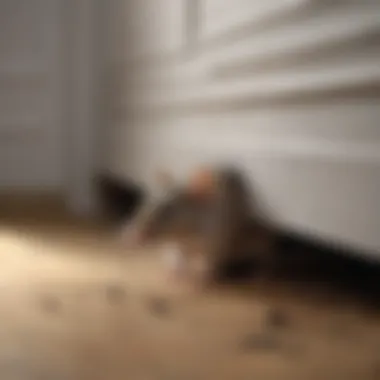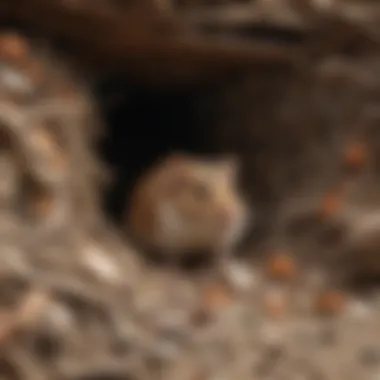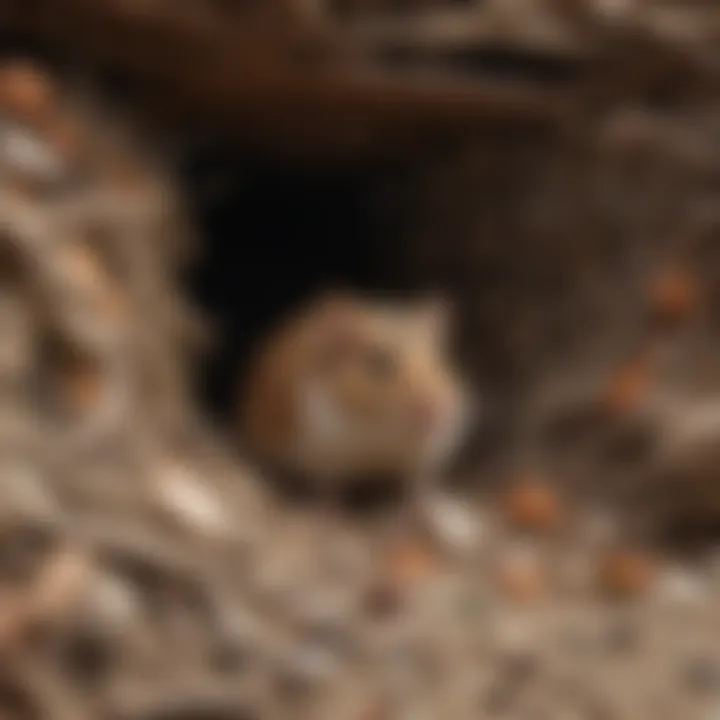Effective Strategies to Prevent Rodents Under Your Home


Intro
Rodents, particularly rats and mice, have a knack for causing trouble when they make their way into our homes. It's more than just a nuisance; these pests can create a real mess, chewing through wiring and contaminating food supplies. Understanding why these creatures are drawn to our living spaces is the first step in keeping them at bay. In this guide, we'll peel back the layers on effective strategies designed to prevent rodents from taking up residence under your home. We will explore everything from prevention techniques to eco-friendly solutions, so you can rest easy knowing your home is secure.
Understanding Pests
Definition of Pests
Pests, in a broad sense, refer to any organism deemed harmful or a nuisance, often infringing on human activities or comfort. Rodents, such as rats and mice, fall under this category due to their destructive tendencies and health hazards. They are clever creatures, highly adaptable and capable of thriving in various environments. It's this very adaptability that makes them such formidable opponents in the battle for our homes.
Importance of Pest Identification
Identifying the specific pests invading your space is crucial. For example, the Norway rat and the roof rat exhibit different behaviors and nesting habits. Knowing what you're dealing with allows for tailored strategies. Not every solution fits every pest. As the saying goes, 'What works for one, may not work for another.'
"Identifying your pest can save you time, money, and countless headaches in the long run."
Whether you spot a droppings trail or hear faint scuttling sounds at night, recognizing these signs can initiate prompt action, and that's key in pest management.
Prevention Techniques
Home and Garden Preventative Measures
The first line of defense against rodent invasions is to fortify your home. Consider these measures:
- Seal Cracks and Gaps: Inspect the foundation and exterior walls for any cracks or openings. Mice can squeeze through an opening as small as a dime.
- Proper Waste Disposal: Regularly empty trash bins and use sealed containers. Rodents are scavengers, and a feast of waste is an open invitation.
- Neglect Overgrown Areas: Ensure your yard is trimmed and tidy. Tall grass and shrubs provide shelter for rodents.
- Store Firewood Away: If you use firewood, stack it at least 20 feet from your home. Firewood piles can attract rodents seeking warmth and shelter.
Seasonal Prevention Tips
Rodents often seek shelter as temperatures drop. Here are some seasonal tips:
- Autumn Checks: Before the cold settles in, conduct a thorough home inspection.
- Winter Maintenance: Keep attics and basements well-ventilated and check for leaks that may attract pests.
- Spring Clean: Spring cleaning isn't just for dusting off old items; it’s a chance to check for any new signs of pest activity.
Eco-Friendly Pest Control Solutions
Overview of Sustainable Practices
With growing environmental concerns, many homeowners are seeking sustainable pest control options. Eco-friendly practices can help manage rodent populations without resorting to harsh chemicals. Incorporating natural barriers or repellents can keep your home pest-free while minimizing impact on the ecosystem.
Natural Remedies and Their Effectiveness
Some natural remedies have gained traction as effective deterrents. Here are a few:
- Peppermint Oil: Rodents find the strong scent of peppermint offensive. Placing cotton balls soaked in peppermint oil around entry points can deter them.
- Cayenne Pepper: Sprinkling cayenne pepper around potential entry points may create an uncomfortable environment for rodents.
- Essential Oils: Other essential oils, such as eucalyptus or clove, may also serve as natural repellents.
By integrating these strategies and solutions into your home maintenance routine, you can create an environment that is uninviting to rodents, preventing them from making a home under your feet.
Understanding the Rodent Problem
Rodents might seem insignificant at first glance, but making light of the situation can lead to serious consequences. Understanding the rodent problem is crucial for homeowners who wish to maintain a safe and healthy living environment. It’s not merely about having a few little critters scurry around. It’s about recognizing the potential health risks and property damage they bring.
By grasping the nature and habits of these pests, one can adopt a proactive stance against infestations. Not all rodents are the same. Some species prefer the tight spaces under our homes as cozy havens. Others might seek food and warmth inside, putting our kitchens and pantries at risk. Therefore, the first step in any prevention strategy is comprehensively understanding which rodents are likely to invade.
Additionally, knowing how these creatures behave allows homeowners to make informed decisions. For instance, their tendency to reproduce quickly means that early detection and action are big deals.
Key Considerations:
- Health Risks: Rodents can carry diseases such as hantavirus and leptospirosis, making it essential to ensure that they don’t get in.
- Damage to Property: Chewing through electrical wiring or pipes can create costly repairs.
- Food Contamination: Rats can spoil food supplies, leading to waste and health hazards.
"An ounce of prevention is worth a pound of cure." It's often said that knowing is half the battle, and being aware of the rodent reality gives homeowners the upper hand to thwart these pests before they make a home beneath their feet.
In the following sections, we will explore the common species of rats that are likely to invade homes, their behavioral patterns, and clear signs of infestation that every homeowner should be on the lookout for. This knowledge will provide the groundwork for implementing effective preventive measures.
Identifying Potential Entry Points


Understanding how rodents breach your home is essential to keep them at bay. Identifying potential entry points helps homeowners act before infestations start. Rodents, especially rats, are resourceful critters, adept at squeezing through incredibly small openings. By recognizing and closing these access points, you significantly reduce the chance of these unwanted guests making themselves at home beneath your floorboards. Not only does this protect your structure, but it also saves you from future headaches and expenses linked to pest control.
Inspecting the Exterior of Your Home
Start by scrutinizing the perimeter of your property. Pay attention to cracks in walls, gaps around pipes, or holes in the foundation; these are common ways for rodents to enter. Rodents can wiggle through spaces as small as a dime, so every little opening counts. Look under your deck and near any structural alterations. If you see wear on wood or nests made of twigs and debris, that's a signal to investigate further. Remember to check windows and doors too—make sure screens are intact and well-fitted.
Common Access Areas
Certain areas around the home tend to provide easier access for rodents:
- Gaps Around Pipes: Often unnoticed, where pipes enter the building can be a prime target for the little invaders.
- Vent Openings: Vents in attics and crawl spaces are crucial for air circulation but can also offer entry for rodents. Ensure they are properly covered with metal mesh.
- Foundation Cracks: Inspect the foundation. If you can see daylight through a crack, chances are those crafty rats can too.
Each of these entry points can act like a welcome mat for rodents, so keep a sharp eye on them.
Utilizing Effective Inspection Techniques
When you set out to inspect your home, it's good to be methodical. A flashlight can be your best friend, casting light into darker corners that are easy to overlook. Look for droppings, gnawed materials, or greasy smudge marks where rodents travel. Another solid tip is to wear gloves and leave out a small handful of flour or cornmeal in suspected areas overnight. The next morning, check for tracks leading to any holes or spots.
This technique not only gives clear evidence of rodent activity but also helps determine where to focus your sealing efforts. Effective inspection paves the way for solid preventive strategies, making your home a less appealing environment for these pests.
"A thorough inspection of your property can make all the difference in preventing costly repairs and the annoyance of a rodent infestation."
Identifying potential entry points requires diligence, but your efforts will pay off. Taking the time now to weed out vulnerable spots will help keep your living space rodent-free in the long run.
Preventive Measures for Rodent Management
When you think about safeguarding your home from unwelcome rodent inhabitants, preventive measures are your first line of defense. Not just a reactive approach, prevention ensures that these little critters can’t even think about making your underbelly their new abode. By adopting a strategy that emphasizes thorough preparedness, homeowners can create an environment that’s less appealing to mice and rats. In other words, a stitch in time saves nine.
Sealing Entry Points
One of the foremost tasks when scuttling away rodents is identifying and sealing entry points. Rats and mice are remarkably adept at squeezing through gaps that seem almost invisible to the naked eye. To illustrate, an adult rat can squeeze through an opening as small as a quarter inch. So, it’s vital to take a thorough walk around the house and look for potential breaches: think cracks in the foundation, spaces around utility lines, or gaps in doors and windows.
- Materials Matters: Use steel wool combined with caulk or foam, as these materials create a formidable barrier that’s hard to chew through. Even a simple weatherstrip might suffice for slightly larger openings.
- Don’t Forget the Roof: The roof isn't off-limits either. Gaps in roof eaves, damaged shingles, or vents that haven’t been properly screened can all serve as access points.
Tip: Always check for signs of gnawing or droppings around these areas. Awareness is half the battle. Identifying and sealing these entry points not only protects your home but also promotes structural integrity, saving you from costly repairs down the line.
Maintaining a Tidy Yard
The importance of a well-kept yard in the battle against rodents cannot be overstated. A tidy yard acts as a deterrent by removing any hiding places and potential nesting materials. Think about it—overgrown grass, piles of wood, or even leftover debris create a cozy shelter for these pests.
- Regular Yard Work: Mow the lawn regularly and keep the landscape well-trimmed. Bushes and shrubs should be at least a foot away from the house to discourage sheltering close to your foundation.
- Debris Management: Remove any piles of branches, leaves, or old furniture that could provide perfect hiding spots. Keep compost bins properly secured. Rodents love compost; it's a buffet for them.
Keep in Mind: An uncluttered yard not only looks good but also reduces the likelihood of rodents finding a safe haven close to home. A clean space can be less than inviting for these tiny intruders.
Proper Waste Management Practices
Effective waste management practices play a pivotal role in steering clear of rodent infestations. Garbage isn’t just an eyesore; it's also an attraction for rodents.
- Secure Trash Containers: Make sure your trash cans are tightly lidded and secured. This not only prevents the smell from tantalizing rodents but also keeps them from foraging and rummaging.
- Compost Wisely: If you’re composting, consider using bins that are rodent-proof. Ensure that scraps are buried under a layer of soil or other materials to minimize accessibility and odors.
- Food Storage: Store pet food and bird seed in airtight containers. Rodents have a keen sense of smell and can detect food from a significant distance.
"An ounce of prevention is worth a pound of cure."
By adopting strategic waste management practices, you’ll not only minimize the possibility of attracting rodents but also contribute to an overall healthier, more inviting home environment. Rodent-proofing your home is a holistic process. Each preventive measure ties into the next, cultivating a comprehensive approach that protects both your property and your peace of mind.
Landscaping Techniques to Minimize Attraction
When aiming to prevent rodents from making your home their cozy abode, landscaping plays a significant role. The way you design and maintain your yard can either invite or deter these uninvited guests. By adopting certain landscaping techniques, you create an environment that is less friendly to rodents. This segment examines specific methods that can be utilized to reduce the risk of rodent attraction.
Choosing the Right Plants
Selecting the right plants is vital. Some plants can attract not just rodents but other pests too. It's wise to steer clear of dense bushes or shrubs that provide ideal nesting spots for rats or mice. Instead, consider opting for plants that are less appealing. Hardy, drought-resistant varieties like lavender or rosemary not only reduce the need for excessive maintenance but also release scents that rodents find unappealing. Additionally, ground covers can reduce the open spaces where rodents might feel safe to roam.
It's also beneficial to incorporate plants that serve as barriers. Thorny shrubs or prickly plants can create an uncomfortable environment for rodents, making them think twice before venturing near your home.
Creating Barriers with Hardscaping


Hardscaping, the non-plant elements of landscaping, can also play a pivotal role in rodent prevention. Building physical barriers often flummoxes these pests. Installing stone walls or gravel paths can create a less hospitable environment. Rodents prefer areas with ample cover, so hardscaping limits their hiding spots significantly.
Furthermore, consider the layout of your outdoor space. Elevated decks or patios can act as protective fixtures, preventing easy access under your home. If you want to go the extra mile, using fencing to create a physical boundary can discourage rodents from the get-go. Make sure any gaps in the fence are tightly sealed; you don’t want to inadvertently create a grand entrance for your furry intruders.
"A well-designed landscape doesn't just look good; it assists in keeping pests at bay."
Managing Mulch and Debris
Mulch can be a double-edged sword in your garden. While it is beneficial for retaining moisture and suppressing weeds, it can also become a hiding place for rodents if not managed properly. Maintaining a shallow layer of mulch and keeping it away from the foundation of your home can greatly reduce this risk.
Moreover, try to keep debris to a minimum. Fallen leaves, wood piles, or shrub clippings attract rodents like moths to a flame. Regular cleaning and removal of such debris will not only enhance the appearance of your yard, but it will also eliminate potential nesting spots.
Eco-Friendly Deterrents
Addressing rodent issues without harming the environment is not just a good idea; it is vital in today's context where sustainability matters more than ever. Eco-friendly deterrents provide effective strategies for keeping rodents at bay while ensuring that we don’t disrupt local ecosystems or harm non-target species. Utilizing these methods can also enhance safety for pets and children. This section will delve into various eco-friendly options that are accessible and practical for homeowners seeking to manage or prevent a rodent problem beneath their homes.
Natural Repellents
Natural repellents come in various forms, from plant-based solutions to homemade mixtures. One standout option is pepper—whether black or cayenne—to deter those pesky rodents. Sprinkling some at entry points can signal to rodents that this territory is best avoided. Another popular choice is garlic, known for its pungent aroma. Mixing garlic powder with water and spraying it around suspected entry points can discourage rodents considerably.
Other options include plants like mint or rosemary, known for their fragrance that is unappealing to rodents. Planting these around your house can also add a lovely aesthetic, while serving a dual purpose. Overall, natural repellents are not only beneficial in keeping away rodents, but they also contribute positively to your garden's biodiversity.
Essential Oils and Their Efficacy
Essential oils have gained popularity for pest control. Ingredients like peppermint oil and eucalyptus oil create strong scents that rodents typically avoid. Using a few drops of these oils in water, then spraying the mixture near entry points can serve as a deterrent. The intensity of these scents disrupts a rodent's sense of smell, signaling danger to them.
It's crucial to note that while essential oils are generally safe, they should be used wisely. For example,
- Keep them out of reach of children and pets.
- Dilute them properly in water to avoid any adverse reactions or irritation.
By employing essential oils thoughtfully, homeowners can tap into their power while preserving the harmony of their living spaces.
Using Traps Effectively
While trapping might seem counterintuitive to a focus on eco-friendly methods, using traps can be a crucial part of a comprehensive approach. The key is choosing humane traps that capture rodents without harming them and allow for release away from your home.
When setting traps, consider these best practices:
- Place traps strategically, particularly in known high-traffic areas.
- Use bait wisely; peanut butter or dried fruit works well, and placing bait inside the trap can entice rodents without exposing them to danger.
- Check traps regularly to ensure any captured rodent is released quickly.
By integrating these eco-friendly deterrents, not only do you manage rodent issues more sustainably, you foster an awareness of the necessary balance needed in controlling rodent populations in urban settings.
"Being mindful of our surroundings while solving pest problems is a win-win for homeowners and the environment."
In essence, these methods provide a way to discourage rodents from frequenting your home without reliance on harmful chemicals, preserving both ecological balance and residential tranquility.
Monitoring and Responding to Infestation
Understanding how to keep an eye on your home is crucial for tackling potential rodent issues effectively. Homeowners can't just lock the doors and hope for the best; that won't cut it when it comes to pests. Monitoring and responding to infestations is a living, breathing part of rodent management. You’ve got to be proactive rather than reactive. This includes developing habits that focus on regular checks and being aware of the signs of a potential rodent problem. The benefits? You’ll have peace of mind and potentially save a lot of hassle and money down the line.
Regular Inspections
Regular inspections are the bread and butter of effective rodent management. It might sound tedious, but this step is akin to checking the oil in your car; neglecting it could lead to far worse consequences.
Carve out some time every few months to closely examine your property, both inside and out. When doing so, pay particular attention to areas that might be more susceptible to a rodent invasion.
- Basis of Inspectable Areas: Check behind appliances, in the attic, and under sinks. These spots are often cozy homes for rodents.
- Weather Changes Matter: During changes in the season, perform inspections more frequently. Rodents often seek shelter from the cold or heat, and your home could seem like a luxurious five-star resort. Don't forget to check outside as well!
- Look For Droppings and Nests: If you spot droppings, you’ve got a heads up that there’s been a visitor. Furthermore, locating any signs of nests can tell you where the activity is centered.
It can be useful to note down your findings. This way, you can track any changes over time.
Assessing the Effectiveness of Measures
After putting preventative measures in place, it’s equally important to evaluate their effectiveness. This isn’t a one-and-done scenario; it requires ongoing assessment. Are those traps working? Have you reduced the number of droppings? Keeping track helps you figure out what works and what doesn’t.


- Swapping Strategies: If something isn’t clicking, reshuffle your review. Sometimes the issue might have been overlooked. Try moving traps to different locations, or consider using a different type of bait.
- Observe Behavior Changes: Over time, if you see a reduction in signs of rat activity, you could be on the right path. Yet, if those signs remain or increase, it’s time to rethink your approach. Remember, every home is different, and what works for one may not work for another.
When to Call Professional Help
There comes a time when DIY just doesn’t cut it. Rodent problems can escalate quickly, and at some point, you may need to hand over the reins to someone who knows their stuff. Here are a few signs that might signal it's time to call in the big guns:
- Continued Presence: If you’re still finding droppings despite having employed methods for a few weeks, consider it a cry for help.
- Widespread Damage: If you notice extensive wiring damage or chewed-up materials, it might be time to get a professional in. Those rodents can cause serious issues if left unchecked.
- A Larger Population: Seeing signs of a full-blown infestation should never be ignored. Bring in experts who can tackle the problem effectively and safely.
In wrapping it up, a proactive approach towards monitoring and responding keeps pesky rodents at bay and protects your home from potential damage. By conducting regular inspections, assessing what works, and knowing when to bring in professionals, you provide your home with the best defense against these uninvited guests.
"The best way to address a problem is to see it coming before it arrives."
These steps will boost your confidence in managing rodent populations and give you more control over your living environment.
Case Studies and Success Stories
In the quest to deter rodents, case studies and success stories serve as invaluable resources. They provide real-world examples of strategies that have worked, offering inspiration and solid proof that successful rodent control is attainable. Homeowners tending to their gardens and households often wonder if the preventive measures they take are effective. Hearing about others' successes can foster hope and provide practical solutions that might not be readily apparent. These narratives empower readers by demonstrating that community effort can yield substantial results, ultimately bolstering confidence in their methods.
Examples of Effective Community Initiatives
One noteworthy example comes from a suburban neighborhood in Ohio. Faced with a rising rodent population, the residents banded together to share their experiences and strategies. They established a monthly meeting to discuss sightings, swap tips, and coordinate actions like sealing off common access points. This collective effort proved successful not only in reducing the rodent population but also in nurturing a sense of community. Residents began noticing fewer signs of infestations, and a dedicated group even started an awareness campaign that educated others on proper waste management practices.
Groups like this underline the significance of community initiatives. When individuals share their challenges and successes, it fosters a helpful atmosphere full of practical tips and advice. For instance, posting informative flyers about rodent habits and preventive methods in public spaces has been shown to raise awareness.
"A small neighborhood effort can yield impressive results in controlling pest populations. "
Personal Experiences from Homeowners
Homeowners often have insightful stories to share, and theirs can shine a light on effective strategies. Jane, a homeowner from California, experienced continual issues with mice in her basement. After learning about how maintaining a clean environment can deter rodents, she committed herself to deep-cleaning regularly and eliminating potential nesting sites.
Through trial and error, Jane discovered that adding peppermint essential oil to her cleaning supplies created a less inviting environment for intruders. She reported a noticeable decline in the visits from furry intruders, which gave her the satisfaction of knowing that the space she maintained was not just visually appealing but secure too.
Similarly, Mark from Texas shared his experience with ongoing rat sightings in his garage. He decided to take it upon himself to seal potential entry points. After researching the best materials, he used steel wool to block small openings and applied a thick layer of caulk to larger gaps. His efforts culminated in a rat-free garage, allowing him confidence to store items without worry.
These individual accounts not only reflect unique strategies but also highlight the broader principle that persistence beats resistance. By learning from others, homeowners can synthesize information and adopt a more proactive approach to rodent management.
Understanding Regulatory Considerations
The topic yet this undercurrent aspect of rodent control, regulatory considerations, is imperative for several reasons. First, it helps homeowners understand the legal framework surrounding pest management within their specific locales. Different regions can have different mandates, which could influence how one approaches rodent prevention and eradication in their homes. Learning about these regulations can prevent unnecessary fines or legal issues that may arise from non-compliance.
Local Ordinances on Rodent Control
When it comes to keeping our homes rodent-free, local ordinances play a crucial part. These are adopted rules set forth by municipal governments that regulate specific practices, including pest management. Places like Chicago or New York City have stringent laws aimed at controlling rat populations; homeowners are expected to comply with these protocols to foster a healthy living environment.
- Zone Regulations: Different areas might have specific requirements. For instance, urban settings often have stricter guidelines compared to rural areas. It’s vital to know what applies in your zone.
- Notification Procedures: Many municipalities require homeowners to report infestations. Knowing how to file a report properly can make the situation less cumbersome.
- Enforcement Mechanisms: Understanding how these regulations are enforced can provide insight into potential fines or penalties if compliance is overlooked.
"When in Rome, do as the Romans do." Familiarizing yourself with local ordinances does not only save you trouble but could also lead to more effective pest management practices.
Safe Use of Chemicals in Urban Areas
As homeowners strive to keep their homes free of rodents, the use of chemicals often comes into play. However, the usage of these substances in urban areas must be executed carefully. Potential risks include harming local wildlife or even affecting public health.
- Choosing Registered Products: Always opt for pest control products that are registered with your local regulatory body. This ensures that the chemicals have been tested for safety and efficacy.
- Application Guidelines: Make sure to follow the application guidelines meticulously. Applying too much or too close to living spaces can lead not only to poor results but also environmental damage.
- Disposal Regulations: Consider how you dispose of any leftover chemicals. Many areas have specific regulations about the safe disposal of hazardous waste that sellers may not mention.
Navigating the world of rodent management does not need to feel like walking through a minefield. By paying attention to local ordinances and understanding how to use chemicals safely, homeowners can create a balanced approach that keeps both their houses and the environment safe.
Epilogue
The conclusion wraps up the various strategies discussed in this article about managing and preventing rodent infestations under your home. It's a vital part of any comprehensive pest control plan, as it emphasizes the ongoing nature of rodent management. Simply put, taking action is not a one-time deal. Homeowners must continually assess and adapt their approaches.
Reflections on Effective Rodent Management
Effective rodent management does not come from a single method or solution but rather a combination of practices tailored to your unique situation. As we’ve uncovered, understanding rodent behavior, identifying potential entry points, and making necessary modifications are all crucial steps that feed into this strategy.
The real key is to remain vigilant. For instance, a homeowner might seal a few holes only to find new ones appear after heavy rain or changes in environment. Furthermore, keeping your home tidy and clutter-free is a short and long-term solution that pays off handsomely in this context. It’s like following a recipe; each ingredient plays a role, and neglecting even one can spoil the dish.
The Importance of Preventative Strategies
When talking about rodent management, the crux lies in preventive action. By focusing on prevention, homeowners not only protect their immediate living environment but also pave the way for long-term success in pest control. Strategies like regular inspections and landscaping choices impact future risks.
Moreover, prevention saves both time and money. It often costs much more to deal with an infestation after it occurs, compared to implementing proactive measures. Things like proper waste management and landscaping decisions create less attractive conditions for rodents to thrive. Thus, you’re not just dodging a bullet but fortifying your home against potential threats. In the grand scheme, integrating these preventive strategies fosters a healthier environment for both residents and the natural ecosystem.



